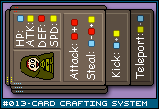|
Mechanic #013 - Card Crafting System |

Category: Card-game | Posted: 05/21/07
A crafting system for a collectable card game. By combining cards, one can produce an item with unique qualities. |
The premise of this idea is to introduce a simple, quick crafting system to a collectable card game - one where you can affect the quality of the outcome depending on what components you use. This idea is relatively simple, but I've not seen anything like it (though my experiences in gaming is mainly of the video sort, so it's possible that it's in one of the many CCG or boardgames I've not had the pleasure to learn yet).
![[craft1.png]](set01/img/entry013-craft1.png)
This illustration is a simplified version of. Basically, you have a product you wish to create. In order to play it, it requires certain components. For instance, if you wanted to craft a sword, you may need a blade and a hilt. Each component has three different colors printed in dots on the edges of the card (in this example, blue on the left, red at top, and yellow on the right).
When you play your product card, you line up the components below it so that only one edge is showing through. For each component, you select a single color to represent it. This example has four cards (not including the optional skills below). I think a typical object may require only one or two components (three cards total), so this is an exaggeration for illustrative purposes.
The stats and abilities of the final product are put in terms of the three different colors. For instance, a sword's attack may be represented by counting up all the yellow dots at the edge of the card. Or perhaps a more complex equations, like blue minus red plus yellow. If this were a computer game, the stats could be calculated automatically. If it was a card game, either the colors would have to be small in number and easy to count AND the formulas would have to be simple and obvious or you'd need a sheet of paper and pencil.
You'll notice that the example also has two additional cards sticking out the bottom. Some components may have additional attributes or skills available, and you can elect to use that stuff instead of one of the colored dots. Or perhaps they can be optional, meaning they would not be required to craft the product, but if you have extra beneficial cards in your hand, you can improve it even further.
This means that in the illustration, there are a total of 7 cards: the product, two skills, two blue, one yellow, and one red. This is an excessive example though. Potentially, one could put all the cards towards blue, leaving yellow at 3 and red at 2, but making blue an excessive six cards worth of blue. In practice, a product would require few required cards and optional cards could come with zero color dots, making sure things stay balanced. Also, balance itself can be achieved by making each color have a specific range of colors, like blue ranges between 2 and 4 dots (mode of 3), while red could be between 1 and 6 dots with equal chance of appearing. |